Tuyen Hoa, with its mountainous terrain and large river system, is a rich and attractive tourist destination. This place possesses many historical relics and national landscapes, such as Admiral Le Truc’s grave, Len Ha cave,… and a traditional boat racing festival. Beautiful villages like Le Son located on the Gianh River, with majestic limestone mountains, are also vivid pictures of this land. In addition, visitors also have the opportunity to explore unique cave systems such as Hang Tien, creating a colorful natural picture. In particular, Tuyen Hoa is not only a destination of natural beauty but also a place to preserve unique traditional culture, from boat racing festivals to Phong Chau ca tru and Kieu singing. Let’s take a look at the outstanding tourist destinations in Tuyen Hoa that you cannot miss!
Len Ha Cave
Len Ha Cave is a historical relic of the Vietnamese revolution, located in Ha village, Thanh Hoa commune, Tuyen Hoa district, Quang Binh province. The cave is located halfway up the limestone mountain west of Truong Son road, with an altitude of 150m, the highest peak is 320m, about 420m wide, about 3 km from strategic route 15A, a place that is often a key point for enemy raids.

In 1967, Communication Station A69 was established, choosing Len Ha Cave as the station. This is one of the most important information stations on the Truong Son route, responsible for communication between the General Command and combat units in the Southern battlefield.
During the war against America to save the country, the officers and soldiers of Station A69 had to endure extremely difficult and dangerous living conditions. They had to live in caves, endure rain, sun, and enemy bombs. However, with a courageous and resilient spirit, the soldiers successfully completed their assigned tasks, making an important contribution to the victory of the resistance war against America to save the country.
On July 2, 1972, the enemy mobilized dozens of B52 and F105 aircraft to attack Len Ha Cave. Station A69 was completely destroyed, 13 officers and soldiers sacrificed their lives heroically. After liberation, Len Ha Cave was ranked as a national historical relic by the Ministry of Culture, Sports and Tourism. Currently, the cave has become a red address to educate patriotic and revolutionary traditions for generations of Vietnamese people.
Len Ha Cave is an attractive tourist destination with profound historical significance. Coming here, visitors will learn about a heroic historical period of the nation, and at the same time pay tribute to those who died for the independence and freedom of the Fatherland. Every year, on July 2, at Len Ha cave, Tuyen Hoa district, Quang Binh province, a memorial ceremony will take place for 13 officers and soldiers of Information Station A69. The memorial service is an opportunity to remember the great contributions of heroic martyrs who sacrificed their lives for the cause of national liberation.



Admiral Le Truc Church
Admiral Le Truc Church is a national historical relic, located in Thanh Thuy village, Tien Hoa commune, Tuyen Hoa district, Quang Binh province. This is the resting place of Admiral Le Truc, a famous Can Vuong insurgent leader in the history of fighting against the French.

Le Truc was born in 1828 in Thanh Thuy village. He was a military officer during the Nguyen Dynasty, participating in many major battles in the resistance war against the French. In 1885, after King Ham Nghi passed down to Can Vuong, he started an army against the French in Quang Binh. His insurgent army achieved many victories, terrifying the French army. In 1887, after many fierce battles, Le Truc’s insurgent army was defeated by the French army.
Le Truc died in his hometown of Thanh Thuy, Quang Binh. In 1912, to commemorate his contributions, local people joined hands to build Le Truc’s church and mausoleum. The church was built in the architectural style of the Nguyen Dynasty. After two wars and the harshness of nature, the church was slightly damaged, but was repaired by people in 1968 and 1985. Currently, the church relics and Le Truc mausoleum are still quite intact. integrity, is an architectural work of historical and artistic value.
Every year, on the anniversary of his death, local people and tourists from all over come here to commemorate and pay tribute to his contributions. Commodore Le Truc Church is an important historical relic, contributing to educating patriotic traditions for the young generation.
Le Son Village
Le Son village is an ancient village located in Van Hoa commune, Tuyen Hoa district, Quang Binh province. The village was founded in 1471 and has a history of more than 500 years. Le Son is known as the “First Eight Famous Fragrances” of Quang Binh, with many ancient legends, charming scenery and literature.

Le Son village is located in the southeast of Tuyen Hoa district, about 15km from the district center. The village has an area of about 770 hectares, located in a low mountainous area, surrounded by the Gianh River to the East and South. North and west of the village are rolling mountains.
Le Son village was established by a group of immigrants from Le Xuyen village, Le Thuy district, Quang Binh province who migrated here to start a business. Initially, the village only had about 30 households, but gradually developed and became one of the largest villages in Tuyen Hoa district. Le Son village has many ancient legends associated with the history of formation and development of the village. One of the most famous myths is the legend of the fairy Chan Linh. According to legend, the fairy Chan Linh descended to earth and met a poor boy in Le Son village. The two fell in love and got married. Then the fairy took the boy to heaven and became a fairy.



Le Son village has a charming natural landscape, with rolling mountains, the romantic Gianh river and stretching rice fields. In the village there are many valuable historical, cultural and artistic relics, such as Le Son communal house, Le Son pagoda, Chan Linh temple,…
The people of Le Son village have a long cultural tradition, with many unique traditional festivals, such as village communal house festival, village pagoda festival, etc. In addition, the village also has many talented artisans and artists, who have has many contributions to the culture of Quang Binh province. People also have many specialty dishes, such as great-grandchildren cooked with yam leaves, banh gai, banh it, Tuyen Hoa honey,…
Le Son village is an attractive tourist destination of Quang Binh province. Coming here, visitors can visit historical, cultural, and artistic relics, enjoy cuisine and learn about the culture of local people.
Ka Tang Bridge
Ka Tang Bridge is a bridge spanning the Gianh River, located in Lam Hoa commune, Tuyen Hoa district, Quang Binh province. The bridge was built in 1966 and was one of the important traffic centers during the resistance war against the US to save the country.

Ka Tang Bridge is located on Route 15A, a vital road connecting the North with the South. Ka Tang Bridge is a steel wire bridge spanning the Gianh River. The bridge is 72m long, 4m wide, 7 to 8m high above the water surface. The bridge played an important role in transporting goods, weapons and manpower to the southern battlefields.
During the war, Ka Tang Bridge was the target of fierce attacks by American aircraft. The bridge has been collapsed many times, but each time our army and people quickly repaired and restored it. Ka Tang Bridge is a place marking the glorious victories of our army and people in the resistance war against the US to save the country. Here, hundreds of officers, soldiers and people sacrificed heroically in the fight to protect the bridge. One of the most outstanding victories was the battle of Company 10 of 37mm anti-aircraft guns (Battalion 11, Regiment 280, of the Air Force Air Defense Command) on January 9, 1968. In this battle, 9 officers and soldiers of the Company heroically sacrificed their lives while on duty to protect Ka Tang Bridge.
In 2013, Ka Tang Bridge was recognized as a special national historical site. After the war, Ka Tang Bridge was rebuilt with reinforced concrete. The current bridge is 120m long and 12m wide.
Minh Cam Bridge
Minh Cam Bridge is a bridge spanning the Gianh River, connecting Phong Hoa and Mai Hoa communes, Tuyen Hoa district, Quang Binh province. The bridge was built in 2003, has a length of 150 meters, a width of 10 meters, and is a vital traffic route of Tuyen Hoa district and neighboring districts.
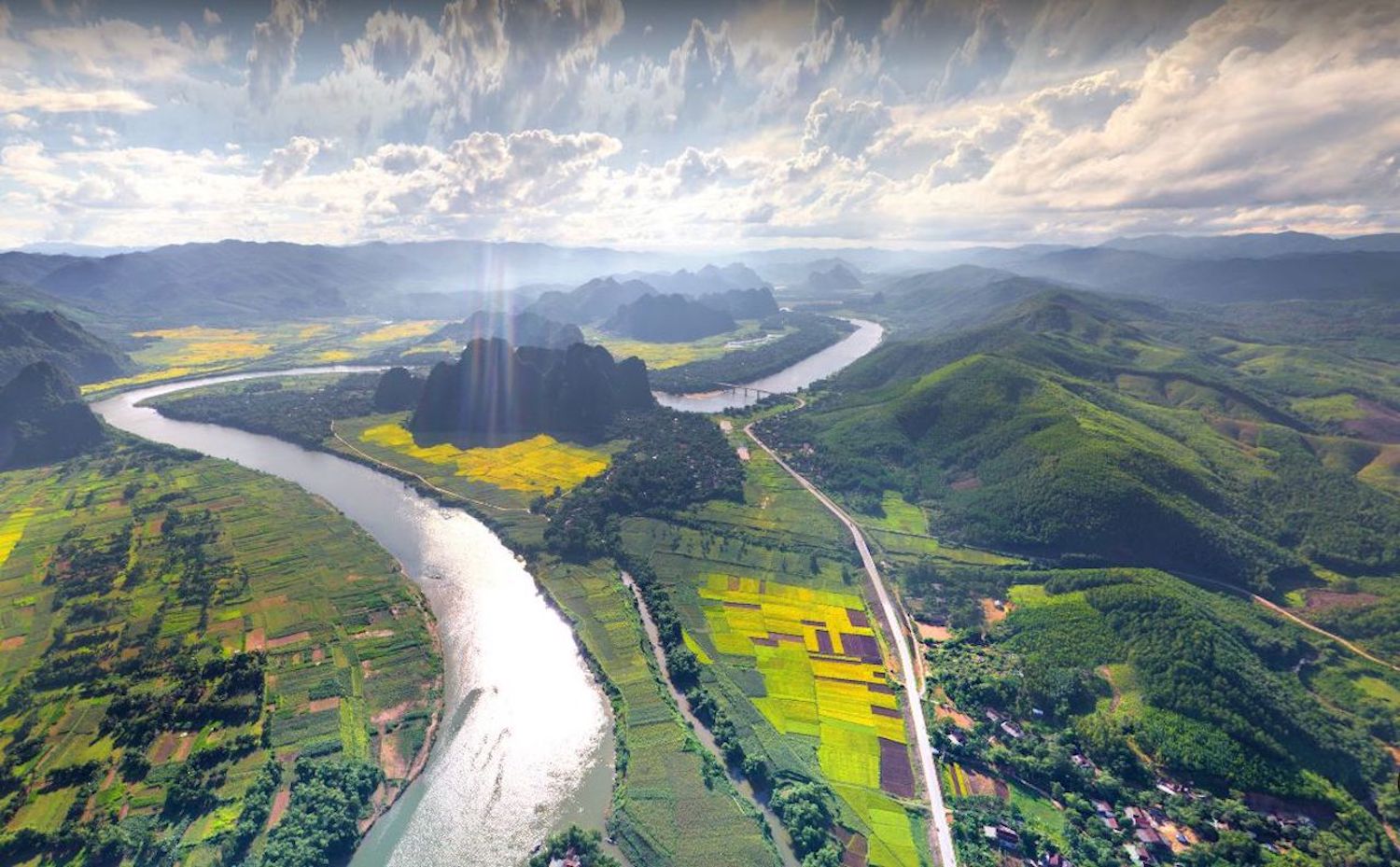

Minh Cam Bridge is located at the intersection of National Highway 12A and the Ho Chi Minh Highway West branch, which is an important route connecting the Central provinces and the Central Highlands. The bridge was built to serve the travel needs of the people and the socio-economic development of the region.
Minh Cam Bridge has an important significance in the socio-economic development of Tuyen Hoa district and neighboring districts. The bridge helps shorten travel time and costs, promote trade and transportation, and contribute to the region’s socio-economic development.
In addition, Minh Cam bridge is also a famous tourist attraction of Tuyen Hoa district. From the bridge, visitors can see the romantic Gianh River, vast green rice fields and rolling mountains.
To get to Minh Cam bridge, visitors can travel by car or motorbike along National Highway 12A or Ho Chi Minh Road West branch. From Dong Hoi city, visitors follow Highway 12A north about 80 km to Minh Cam bridge.
Bai Duc
Bai Duc is a historical place located in Huong Hoa commune, Tuyen Hoa district, Quang Binh province. This is where the first Communist Party cell in Northern Quang Binh was established on January 12, 1931.
Bai Duc is a land with an important strategic position, located at the traffic gateway between Tuyen Hoa district and Huong Khe and Can Loc districts of Ha Tinh province. This land has a tradition of patriotism and fighting against foreign invaders.

In 1930, the Soviet-Nghe Tinh movement spread to Bai Duc land. Under the leadership of the Communist Party of Vietnam, the people of Bai Duc stood up to fight against the French colonialists and feudal henchmen.
On January 12, 1931, south of Tan Duc bridge, under the chairmanship of comrade Tran Ich, Bai Duc Communist Party Cell was established. The Party cell consists of 7 official party members, with comrade Tran Dinh as secretary.
After its establishment, Bai Duc Party Cell led the people in the region to fight against the policies of exploitation and oppression of the colonialists and feudalists. The cell has established mass organizations such as Red Salvation, Red Farm Association, Mutual Aid Association, etc. to gather revolutionary forces.
Bai Duc Party Cell is a cell with important historical significance for the Party and people of Quang Binh. The cell made an important contribution to promoting the revolutionary movement in northern Quang Binh, contributing to the victory of the August Revolution in 1945 and the nation’s resistance wars against foreign invaders.
Currently, Bai Duc relic is built into a provincial historical relic site. Here, there are memorial stele houses, monuments, exhibition houses, etc. to record the history and revolutionary struggle traditions of the Bai Duc people.
Coming to Bai Duc relic, visitors will learn about one of the important historical events of the Party Committee and people of Quang Binh. Visitors will also admire the beautiful natural landscape of Tuyen Hoa land.
Chan Linh Cave
Chan Linh Cave is a famous scenic spot in the west of Le Son village, Van Hoa commune, Tuyen Hoa district, Quang Binh province. The cave is located in the heart of a limestone mountain containing a railway tunnel called Le Son tunnel; This place is marked by the demarcation between Kinh Chau village (in Chau Hoa commune) and Le Son village (Culture). The limestone mountain containing this cave protrudes from the water of the Gianh River.
According to ancient books, Chan Linh cave has a history dating back millions of years. The cave is about 100m long, about 50m wide, and about 10m high. The ceiling of the cave has many stalactites, stone columns, stalagmites,… with strange, diverse, shimmering, and magnificent shapes. In the cave there are many small sub-cave, connected to each other.
Chan Linh Cave is associated with many stories and legends. According to legend, Chan Linh cave is the residence of a beautiful fairy with powerful magic. The fairy often helps people in the area, so she is respected and worshiped by the people.
Through historical changes, the Chan Linh cave entrance has been covered since the 19th century. In the early 20th century, the French colonial government drilled into the mountains to build a railway through here, further changing the landscape and cave entrance.

Today, Chan Linh cave is still a famous scenic spot of Quang Binh. Visitors to Chan Linh cave can not only admire the majestic beauty of the cave, but also learn about the myths and legends associated with the cave.
To get to Chan Linh cave, visitors can follow National Highway 1A to Tuyen Hoa district. From the center of Tuyen Hoa district, visitors follow the Ho Chi Minh Highway west about 10km and will reach Le Son village. From here, visitors follow a small dirt road along the Gianh river for about 1km to reach Chan Linh cave.
Chan Linh Cave is currently being renovated, preserved and developed for tourism. This is an attractive tourist destination, promising to bring visitors interesting experiences.
Minh Cam Cave
Minh Cam Cave is a famous archaeological and tourist relic of Quang Binh province, located in Minh Cam village, Phong Hoa commune, Tuyen Hoa district. The cave was discovered in 1922 by archaeologist E. Patte, and has been excavated many times over the years.
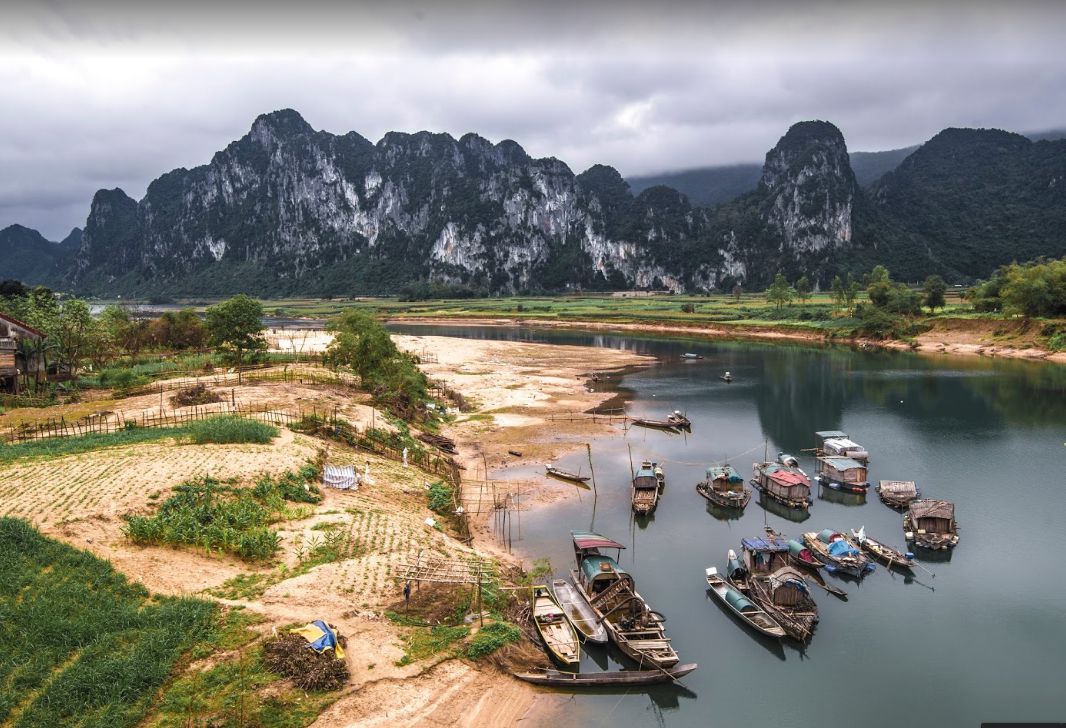 On the way back to Minh Cam village, you will have the opportunity to encounter many beautiful moments. Photo: Phong Nha Explorer
On the way back to Minh Cam village, you will have the opportunity to encounter many beautiful moments. Photo: Phong Nha Explorer
Minh Cam Cave was formed from the geological tectonic process of limestone. The cave has a wide door formed by 3 rocks clustered together. The cave is about 300m2 wide and about 10m high. In the cave there are many stalactites, stalagmites and interestingly shaped rocks.
In Minh Cam cave, archaeologists have found many ancient relics, including pottery, stoneware, bronze, etc. These relics show that Minh Cam cave was once inhabited by ancient Vietnamese people long ago. more than 5,000 years.
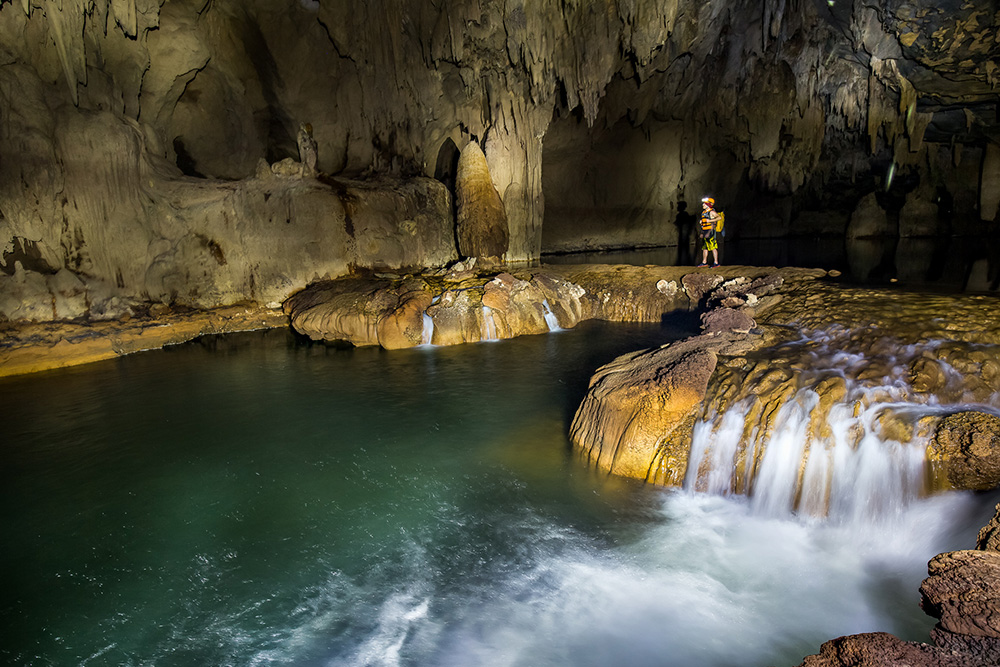
In addition to archaeological value, Minh Cam cave also has tourism value. The cave is located in a convenient location, about 70km from Dong Hoi city center. The road to Minh Cam cave is quite easy, you can go by motorbike or car.
At Minh Cam cave, visitors can visit and admire the beauty of the cave and learn about the history and culture of ancient Vietnamese people. In addition, visitors can also experience ecotourism activities, such as boating on the Gianh River and visiting Minh Cam village.
Langur viewing spot in Thach Hoa
Thach Hoa, Tuyen Hoa district, Quang Binh province is one of the ideal places to see Ha Tinh langurs, a rare primate species listed in the Vietnam Red Book. Currently, in Thach Hoa there are about 100 individual langurs living and breeding.
To get to the langur viewing spot, visitors can ride a motorbike or car along Ho Chi Minh Road to Tuyen Hoa town, then turn onto provincial road 555. From the center of Tuyen Hoa town, visitors travel about 15km is to Thiet Son village, where the home of Mr. Nguyen Thanh Tu, who has spent many years protecting the langur herd, is located.
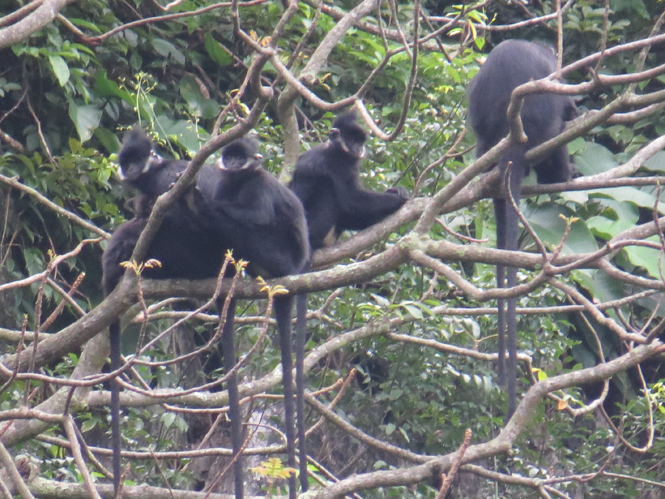 |
| The langur herd is growing more and more thanks to the protection of dedicated people in Thach Hoa and Dong Hoa |
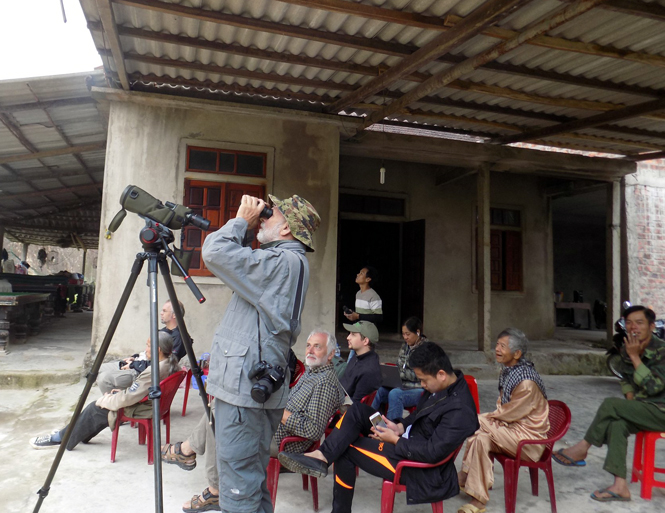 |
| A group of scientists from zoos in Germany, Belgium and India came to Thach Hoa to watch langurs. |
The most famous langur viewing spot in Thach Hoa is the home of Mr. Nguyen Thanh Tu, a retired border guard who has volunteered to protect the langurs over the past time. Mr. Tu’s house is located in Thiet Son village, Thach Hoa commune, about 15km from Tuyen Hoa district center. From Mr. Tu’s house, visitors can easily observe the flock of langurs living in the surrounding treetops
When coming to Thach Hoa, visitors can enjoy coffee and watch langurs. There are several cafes in Thach Hoa that have beautiful views of the langur habitat. To see langurs in Thach Hoa, visitors should come in the early morning or late afternoon. This is the time when langurs often come out of their burrows to feed and be active. When watching langurs, visitors need to keep a safe distance and not affect the habitat of this animal.
Temple of Dialectics for Academician Tran Canh Huong (Van Hoa commune)
The temple worshiping the Great Academician Tran Canh Huong is located in Van Hoa commune, Tuyen Hoa district, Quang Binh province. This is a valuable historical and cultural relic, associated with the formation and development of Le Son village, one of the “Eight famous fragrances” of Quang Binh.
The temple was built during the Le Dynasty, on a high, airy plot of land, with an area of about 200 square meters. The temple is designed in the Dinh style, including three main rooms and a harem. The main space is the place to worship the Great Academician Tran Canh Huong, the secondary space is to worship the ancestors of the Tran family and the village’s predecessors. The harem is the place to worship the village’s gods.
The shrine is built with wooden materials and roofed with yin and yang tiles. The main space is decorated with horizontal paintings and parallel sentences in Chinese characters. The harem is decorated with statues worshiping gods.
Dialectics University scholar Tran Canh Huong is a cultural celebrity of Quang Binh. He was born around the 15th century, into a general’s family in Lap Thach district, Vinh Phuc province. He passed the Huong and Hoi exams highly and was appointed as a mandarin in the royal court. However, he soon resigned and returned to Le Son village to open a teaching school.
His teaching career has made an important contribution to the development of the studious tradition of Le Son village. Thanks to his teaching, many children of Le Son village have passed exams and become useful people for society.
The Temple of Hierarchy for Academician Tran Canh Huong is a valuable historical and cultural relic. This is where the traditional cultural values of Le Son village, one of the ancient cultural villages of Quang Binh, are preserved.
The Memorial Festival for Academician Tran Canh Huong is held annually on the 18th day of the 12th lunar month. The festival includes activities such as: sacrifices, palanquin processions, cultural competitions, etc. This is an opportunity for the people of Le Son village to remember his gratitude and at the same time show their pride in the village’s tradition of studious learning. .
Mr. Le An’s house and Cay Loi cave (Tien Hoa commune)
Mr. Le An’s house and Cay Loi cave are a provincial historical-cultural relic of Quang Binh province, located in hamlet 1, Tien Hoa commune, Tuyen Hoa district. The relic is about 15km from the center of Tuyen Hoa district in the Northwest direction.
Mr. Le An’s house is an ancient house dating back about 300 years, built in the stilt house style of ethnic minorities. The house is made of ironwood, the roof is covered with yin and yang tiles. Inside the house there is an ancestral worship space, a reception room and a kitchen.
Cay Loi Cave is a small cave located right next to Mr. Le An’s house. The cave is about 50m long and about 10m wide. The cave was formed by the erosion of rainwater over thousands of years. Inside the cave there are many stalactites and stalagmites creating unique shapes.
The relics of Mr. Le An’s House and Cay Loi Cave are associated with important historical events of the nation. During the resistance war against the French, this house and cave were used as a place to hide weapons, food and as a place of activity for revolutionary officers and soldiers.
Currently, the relics of Mr. Le An’s House and Cay Loi cave are an attractive tourist destination of Tuyen Hoa district. Coming to the relic, visitors can not only visit an ancient house and a beautiful cave but also learn about the historical and cultural values of the relic.
Tuyen Hoa is not only a tourist destination, but also a journey to discover diverse beauty, profound history and unique traditional culture. Every corner, every monument is a page of history, a “work of art” of nature and people. So, let Tuyen Hoa make your travel journey special and discover memorable moments in this land.